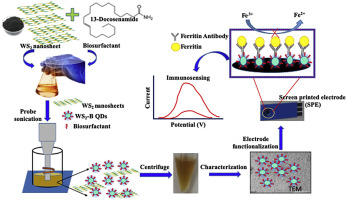当前位置:
X-MOL 学术
›
Biosens. Bioelectron.
›
论文详情
Our official English website, www.x-mol.net, welcomes your feedback! (Note: you will need to create a separate account there.)
Label-free approach for electrochemical ferritin sensing using biosurfactant stabilized tungsten disulfide quantum dots.
Biosensors and Bioelectronics ( IF 12.6 ) Pub Date : 2019-12-21 , DOI: 10.1016/j.bios.2019.111979 Mayank Garg 1 , Mary Chatterjee 2 , Amit L Sharma 1 , Suman Singh 1
Biosensors and Bioelectronics ( IF 12.6 ) Pub Date : 2019-12-21 , DOI: 10.1016/j.bios.2019.111979 Mayank Garg 1 , Mary Chatterjee 2 , Amit L Sharma 1 , Suman Singh 1
Affiliation

|
A novel approach for the synthesis of biosurfactant stabilized/functionalized tungsten disulfide (WS2-B) quantum dots (QDs) and its application for ferritin immunosensor is reported. These 2-D layered material derived quantum dots are synthesized via one-step liquid exfoliation method and biosurfactant was used as a functionalization and stability providing moiety. The biosurfactant provided a clean and green method for both the synthesis and in-situ functionalization of the QDs. Exhaustive characterization using analytical techniques was done to study various aspects of the synthesized quantum dots. The functionalized quantum dots (WS2-B QDs) were further explored for their possible application as an electroactive platform. For this, the working area of commercially available screen-printed electrodes (SPE) was functionalized with these WS2-B QDs to construct a sensor platform. This sensor platform was then used for fabrication of ferritin immunosensor, using ferritin specific antibodies. Cyclic Voltammetry (CV) and Differential Pulse Voltammetry (DPV) techniques were used for electrochemical immunosensing of ferritin. Though, the achieved linear range for ferritin detection (10-1500 ng mL-1) is same with both the techniques but regression coefficient and limit of detection are better in differential pulse voltammetry. The limit of detection was found to be 3.800 ng mL-1 in DPV and 6.048 ng mL-1 in CV. The immunosensor is highly selective, reproducible and is stable for about 60 days.
中文翻译:

使用生物表面活性剂稳定的二硫化钨量子点进行电化学铁蛋白检测的无标记方法。
报道了一种合成生物表面活性剂稳定/功能化二硫化钨(WS2-B)量子点(QDs)的新方法及其在铁蛋白免疫传感器中的应用。这些二维层状材料衍生的量子点通过一步液体剥落法合成,并将生物表面活性剂用作功能化和提供稳定性的部分。生物表面活性剂为量子点的合成和原位功能化提供了一种清洁绿色的方法。使用分析技术进行了详尽的表征,以研究合成量子点的各个方面。进一步研究了功能化量子点(WS2-B QD)作为电活性平台的可能应用。为了这,使用这些WS2-B QD对市售的丝网印刷电极(SPE)的工作区域进行功能化,以构建传感器平台。然后使用铁蛋白特异性抗体将该传感器平台用于铁蛋白免疫传感器的制造。循环伏安法(CV)和差分脉冲伏安法(DPV)技术用于铁蛋白的电化学免疫传感。虽然,铁蛋白检测的线性范围(10-1500 ng mL-1)与这两种技术相同,但在差分脉冲伏安法中回归系数和检测极限更好。发现检测限为DPV中的3.800 ng mL-1和CV中的6.048 ng mL-1。免疫传感器具有高度选择性,可重现性,并且稳定约60天。然后使用铁蛋白特异性抗体将该传感器平台用于铁蛋白免疫传感器的制造。循环伏安法(CV)和差分脉冲伏安法(DPV)技术用于铁蛋白的电化学免疫传感。虽然,铁蛋白检测的线性范围(10-1500 ng mL-1)与这两种技术相同,但在差分脉冲伏安法中回归系数和检测极限更好。发现检测限为DPV中的3.800 ng mL-1和CV中的6.048 ng mL-1。免疫传感器具有高度选择性,可重现性,并且稳定约60天。然后使用铁蛋白特异性抗体将该传感器平台用于铁蛋白免疫传感器的制造。循环伏安法(CV)和差分脉冲伏安法(DPV)技术用于铁蛋白的电化学免疫传感。虽然,铁蛋白检测的线性范围(10-1500 ng mL-1)与这两种技术相同,但在差分脉冲伏安法中回归系数和检测极限更好。发现检测限为DPV中的3.800 ng mL-1和CV中的6.048 ng mL-1。免疫传感器具有高度选择性,可重现性,并且稳定约60天。铁蛋白检测的线性范围(10-1500 ng mL-1)与这两种技术均相同,但在差分脉冲伏安法中回归系数和检测极限更好。发现检测限为DPV中的3.800 ng mL-1和CV中的6.048 ng mL-1。免疫传感器具有高度选择性,可重现性,并且稳定约60天。铁蛋白检测的线性范围(10-1500 ng mL-1)与这两种技术均相同,但在差分脉冲伏安法中回归系数和检测极限更好。发现检测限为DPV中的3.800 ng mL-1和CV中的6.048 ng mL-1。免疫传感器具有高度选择性,可重现性,并且稳定约60天。
更新日期:2019-12-21
中文翻译:

使用生物表面活性剂稳定的二硫化钨量子点进行电化学铁蛋白检测的无标记方法。
报道了一种合成生物表面活性剂稳定/功能化二硫化钨(WS2-B)量子点(QDs)的新方法及其在铁蛋白免疫传感器中的应用。这些二维层状材料衍生的量子点通过一步液体剥落法合成,并将生物表面活性剂用作功能化和提供稳定性的部分。生物表面活性剂为量子点的合成和原位功能化提供了一种清洁绿色的方法。使用分析技术进行了详尽的表征,以研究合成量子点的各个方面。进一步研究了功能化量子点(WS2-B QD)作为电活性平台的可能应用。为了这,使用这些WS2-B QD对市售的丝网印刷电极(SPE)的工作区域进行功能化,以构建传感器平台。然后使用铁蛋白特异性抗体将该传感器平台用于铁蛋白免疫传感器的制造。循环伏安法(CV)和差分脉冲伏安法(DPV)技术用于铁蛋白的电化学免疫传感。虽然,铁蛋白检测的线性范围(10-1500 ng mL-1)与这两种技术相同,但在差分脉冲伏安法中回归系数和检测极限更好。发现检测限为DPV中的3.800 ng mL-1和CV中的6.048 ng mL-1。免疫传感器具有高度选择性,可重现性,并且稳定约60天。然后使用铁蛋白特异性抗体将该传感器平台用于铁蛋白免疫传感器的制造。循环伏安法(CV)和差分脉冲伏安法(DPV)技术用于铁蛋白的电化学免疫传感。虽然,铁蛋白检测的线性范围(10-1500 ng mL-1)与这两种技术相同,但在差分脉冲伏安法中回归系数和检测极限更好。发现检测限为DPV中的3.800 ng mL-1和CV中的6.048 ng mL-1。免疫传感器具有高度选择性,可重现性,并且稳定约60天。然后使用铁蛋白特异性抗体将该传感器平台用于铁蛋白免疫传感器的制造。循环伏安法(CV)和差分脉冲伏安法(DPV)技术用于铁蛋白的电化学免疫传感。虽然,铁蛋白检测的线性范围(10-1500 ng mL-1)与这两种技术相同,但在差分脉冲伏安法中回归系数和检测极限更好。发现检测限为DPV中的3.800 ng mL-1和CV中的6.048 ng mL-1。免疫传感器具有高度选择性,可重现性,并且稳定约60天。铁蛋白检测的线性范围(10-1500 ng mL-1)与这两种技术均相同,但在差分脉冲伏安法中回归系数和检测极限更好。发现检测限为DPV中的3.800 ng mL-1和CV中的6.048 ng mL-1。免疫传感器具有高度选择性,可重现性,并且稳定约60天。铁蛋白检测的线性范围(10-1500 ng mL-1)与这两种技术均相同,但在差分脉冲伏安法中回归系数和检测极限更好。发现检测限为DPV中的3.800 ng mL-1和CV中的6.048 ng mL-1。免疫传感器具有高度选择性,可重现性,并且稳定约60天。



























 京公网安备 11010802027423号
京公网安备 11010802027423号